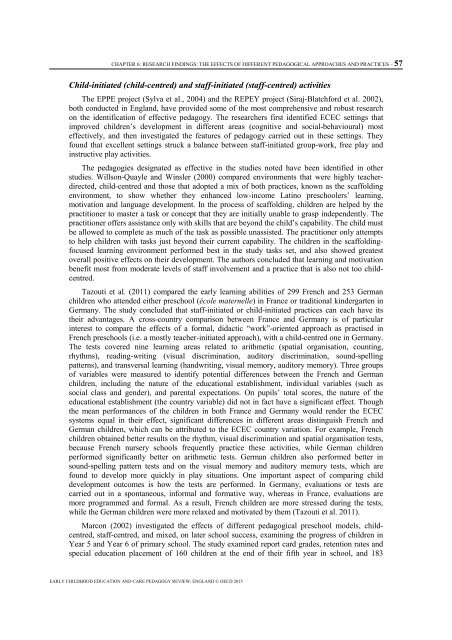early-childhood-education-and-care-pedagogy-review-england.pdf?utm_content=bufferb49b1&utm_medium=social&utm_source=twitter
early-childhood-education-and-care-pedagogy-review-england.pdf?utm_content=bufferb49b1&utm_medium=social&utm_source=twitter
early-childhood-education-and-care-pedagogy-review-england.pdf?utm_content=bufferb49b1&utm_medium=social&utm_source=twitter
Create successful ePaper yourself
Turn your PDF publications into a flip-book with our unique Google optimized e-Paper software.
CHAPTER 6: RESEARCH FINDINGS: THE EFFECTS OF DIFFERENT PEDAGOGICAL APPROACHES AND PRACTICES – 57Child-initiated (child-centred) <strong>and</strong> staff-initiated (staff-centred) activitiesThe EPPE project (Sylva et al., 2004) <strong>and</strong> the REPEY project (Siraj-Blatchford et al. 2002),both conducted in Engl<strong>and</strong>, have provided some of the most comprehensive <strong>and</strong> robust researchon the identification of effective <strong>pedagogy</strong>. The researchers first identified ECEC settings thatimproved children’s development in different areas (cognitive <strong>and</strong> social-behavioural) mosteffectively, <strong>and</strong> then investigated the features of <strong>pedagogy</strong> carried out in these settings. Theyfound that excellent settings struck a balance between staff-initiated group-work, free play <strong>and</strong>instructive play activities.The pedagogies designated as effective in the studies noted have been identified in otherstudies. Willson-Quayle <strong>and</strong> Winsler (2000) compared environments that were highly teacherdirected,child-centred <strong>and</strong> those that adopted a mix of both practices, known as the scaffoldingenvironment, to show whether they enhanced low-income Latino preschoolers’ learning,motivation <strong>and</strong> language development. In the process of scaffolding, children are helped by thepractitioner to master a task or concept that they are initially unable to grasp independently. Thepractitioner offers assistance only with skills that are beyond the child’s capability. The child mustbe allowed to complete as much of the task as possible unassisted. The practitioner only attemptsto help children with tasks just beyond their current capability. The children in the scaffoldingfocusedlearning environment performed best in the study tasks set, <strong>and</strong> also showed greatestoverall positive effects on their development. The authors concluded that learning <strong>and</strong> motivationbenefit most from moderate levels of staff involvement <strong>and</strong> a practice that is also not too childcentred.Tazouti et al. (2011) compared the <strong>early</strong> learning abilities of 299 French <strong>and</strong> 253 Germanchildren who attended either preschool (école maternelle) in France or traditional kindergarten inGermany. The study concluded that staff-initiated or child-initiated practices can each have itstheir advantages. A cross-country comparison between France <strong>and</strong> Germany is of particularinterest to compare the effects of a formal, didactic “work”-oriented approach as practised inFrench preschools (i.e. a mostly teacher-initiated approach), with a child-centred one in Germany.The tests covered nine learning areas related to arithmetic (spatial organisation, counting,rhythms), reading-writing (visual discrimination, auditory discrimination, sound-spellingpatterns), <strong>and</strong> transversal learning (h<strong>and</strong>writing, visual memory, auditory memory). Three groupsof variables were measured to identify potential differences between the French <strong>and</strong> Germanchildren, including the nature of the <strong>education</strong>al establishment, individual variables (such associal class <strong>and</strong> gender), <strong>and</strong> parental expectations. On pupils’ total scores, the nature of the<strong>education</strong>al establishment (the country variable) did not in fact have a significant effect. Thoughthe mean performances of the children in both France <strong>and</strong> Germany would render the ECECsystems equal in their effect, significant differences in different areas distinguish French <strong>and</strong>German children, which can be attributed to the ECEC country variation. For example, Frenchchildren obtained better results on the rhythm, visual discrimination <strong>and</strong> spatial organisation tests,because French nursery schools frequently practice these activities, while German childrenperformed significantly better on arithmetic tests. German children also performed better insound-spelling pattern tests <strong>and</strong> on the visual memory <strong>and</strong> auditory memory tests, which arefound to develop more quickly in play situations. One important aspect of comparing childdevelopment outcomes is how the tests are performed. In Germany, evaluations or tests arecarried out in a spontaneous, informal <strong>and</strong> formative way, whereas in France, evaluations aremore programmed <strong>and</strong> formal. As a result, French children are more stressed during the tests,while the German children were more relaxed <strong>and</strong> motivated by them (Tazouti et al. 2011).Marcon (2002) investigated the effects of different pedagogical preschool models, childcentred,staff-centred, <strong>and</strong> mixed, on later school success, examining the progress of children inYear 5 <strong>and</strong> Year 6 of primary school. The study examined report card grades, retention rates <strong>and</strong>special <strong>education</strong> placement of 160 children at the end of their fifth year in school, <strong>and</strong> 183EARLY CHILDHOOD EDUCATION AND CARE PEDAGOGY REVIEW: ENGLAND © OECD 2015



